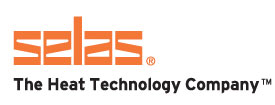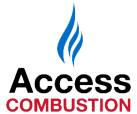Choosing the right equipment for your thermal processing system.
Thermal Equipment principles are known for their huge variety of products,
for good reason. Experience has shown that carefully matching equipment to
application provides significant gains in efficiency. Less fuel equals less
money spent! The variables considered in choosing the correct burners, controls and
accessories include flame geometry, flame velocity, control methods and many
others.
Resist the urge to get a larger burner than you need. Burners are often the most efficient near the top of their rated output. An over-sized burner may have an over-sized combustion air blower that needs a damper to reduce the airflow, thus wasting electricity, in addition to combustion inefficiency.
Air to Fuel ratio controls can be thought of like a carburetor in an automobile. The ratio may be controlled by mechanical means like a butterfly valve. Because the operating environment can change drastically over time by such things as dirty air filters, ambient temperature and barometric pressure, these mechanical devices may lead to further inefficiencies. Modern manufactures of airflow control systems have integrated smart controls that ensure optimum efficiency while reducing emissions by automating the air/fuel mix.
Select a firing method
Direct firing may be the most efficient as the flame is heating the load, but not all applications can accept direct heating, so a tube burner or other indirect firing system may be required. A good example of this is when the product to be heated is a liquid and the selected burner is the Eclipse ImmersoJet nozzle-mix, tube-firing burner which fires through a small diameter immersion tube in liquid heating tanks.
Consider turndown ratio
You may need to bring your oven, furnace or kiln up to operating temperature quickly, thus needing a high BTU/hr startup, but the process may require a plateau in the heat level, thus requiring a lower BTU/hr during that time, and perhaps an even lower setting during a slow cool down period, rather than just shutting the burner down. A high turndown ratio ensures this is possible.
Put some thought into how you mount your burners. Wall mounting is convenient for easier access during maintenance, but mounting the burner in the duct will generally result in less heat loss.
How will you ignite the burner?
You might burn a pilot flame, or you might choose a spark ignition. Your chosen burner might make this choice for you, or it might support both. Your process may benefit more from one or the other.
You don't have to decide on your own. Thermal Equipment Systems, Inc. has been dealing in industrial burner equipment since 1972. Give us a call and we'll help you determine the best components to build the most efficient and effective system for your industrial heating process.
Resist the urge to get a larger burner than you need. Burners are often the most efficient near the top of their rated output. An over-sized burner may have an over-sized combustion air blower that needs a damper to reduce the airflow, thus wasting electricity, in addition to combustion inefficiency.
Air to Fuel ratio controls can be thought of like a carburetor in an automobile. The ratio may be controlled by mechanical means like a butterfly valve. Because the operating environment can change drastically over time by such things as dirty air filters, ambient temperature and barometric pressure, these mechanical devices may lead to further inefficiencies. Modern manufactures of airflow control systems have integrated smart controls that ensure optimum efficiency while reducing emissions by automating the air/fuel mix.
Select a firing method
Direct firing may be the most efficient as the flame is heating the load, but not all applications can accept direct heating, so a tube burner or other indirect firing system may be required. A good example of this is when the product to be heated is a liquid and the selected burner is the Eclipse ImmersoJet nozzle-mix, tube-firing burner which fires through a small diameter immersion tube in liquid heating tanks.
Consider turndown ratio
You may need to bring your oven, furnace or kiln up to operating temperature quickly, thus needing a high BTU/hr startup, but the process may require a plateau in the heat level, thus requiring a lower BTU/hr during that time, and perhaps an even lower setting during a slow cool down period, rather than just shutting the burner down. A high turndown ratio ensures this is possible.
Put some thought into how you mount your burners. Wall mounting is convenient for easier access during maintenance, but mounting the burner in the duct will generally result in less heat loss.
How will you ignite the burner?
You might burn a pilot flame, or you might choose a spark ignition. Your chosen burner might make this choice for you, or it might support both. Your process may benefit more from one or the other.
You don't have to decide on your own. Thermal Equipment Systems, Inc. has been dealing in industrial burner equipment since 1972. Give us a call and we'll help you determine the best components to build the most efficient and effective system for your industrial heating process.


















